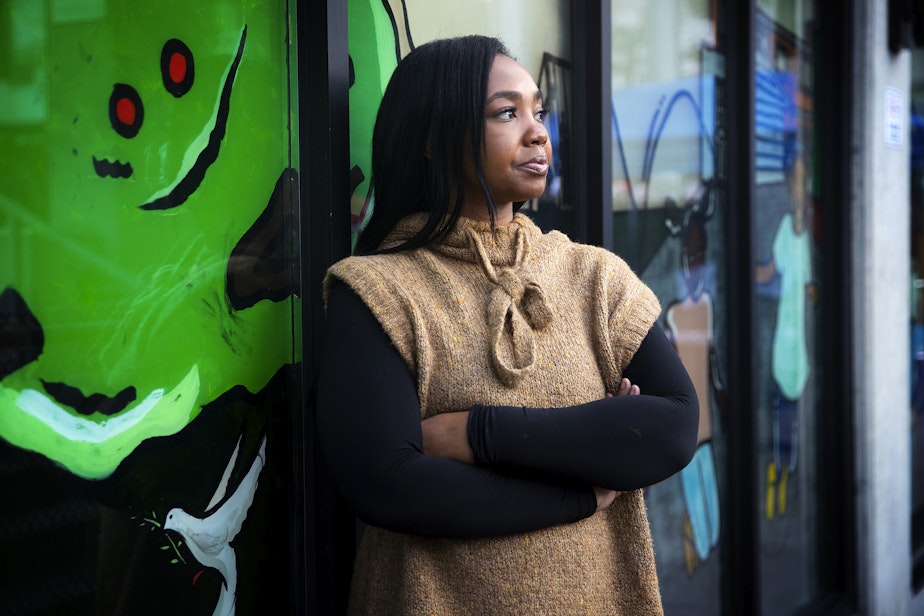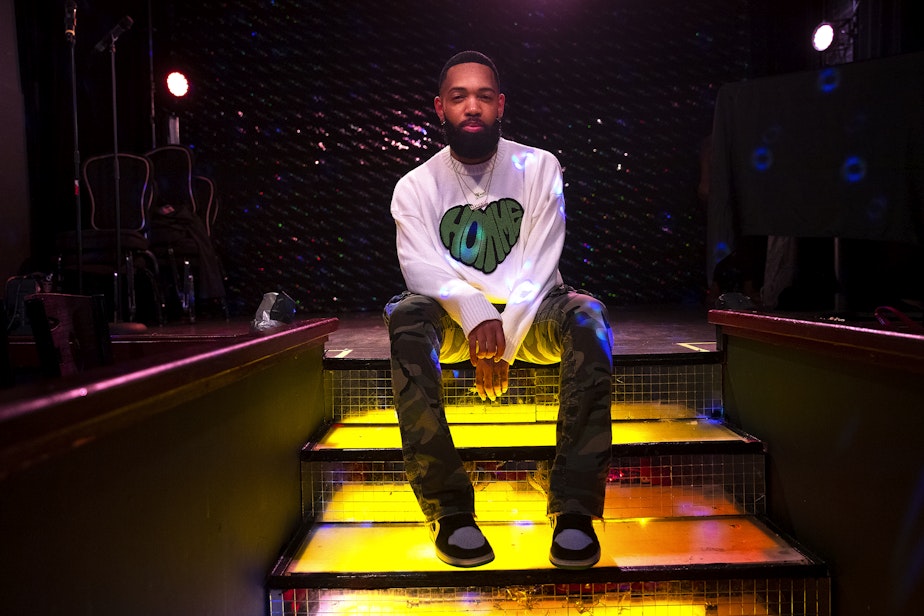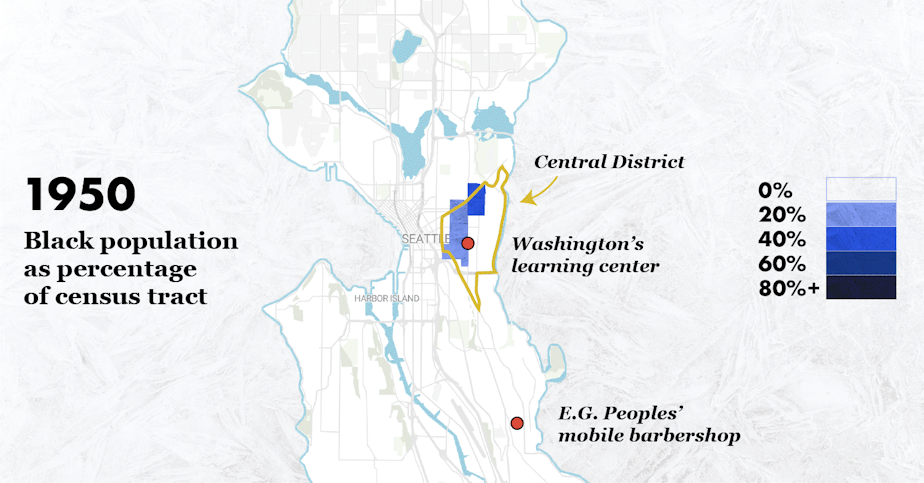'From the Central to the south,' Seattle neighborhoods ask for an engaged police force

Seattleites took to the streets and the polls in 2020 to demand sweeping changes to policing and public safety. Four years later, the Seattle Police Department is grappling with record-breaking crime and multiple department scandals. KUOW took a look at how the department is faring today.
S
ince the age of 16, E.G. Peoples has been working as a community barber, giving out fades and tapers, and edging-up hairlines now using a renovated and electrified bus as his barbershop. The carport that he started out in has evolved to a small garage, sitting between a two-story brick house and a yellow house in Rainier Beach.
Peoples moved out pretty young, but life brought him and his kids back to the brick home, which used to belong to his grandma. His dad lives in the yellow house next door.
“He built that house, him and his friends, like 12 years ago,” Peoples said.
Over the years, Peoples has taken others under his wing and taught them how to become barbers on their own. He’s been able to see people through many phases of their lives — especially young men — starting out as kids and growing into adulthood. Occasionally Peoples runs into police officers when he cuts kids' hair at youth events and pop-ups in and around Rainier Beach.
“There are always a lot of officers there,” Peoples said. “I've actually met some cool officers ... on their off-duty time, they're doing stuff in the community, teaching, and all the good things. I like to see people helping people, period. I will say [the relationship between police and the neighborhood] it's okay. I mean, you could always be better.”
Peoples is one of three Seattleites KUOW spoke with who say they want to see Seattle Police be better at building relationships and having consistent, engaged communication with their communities.
The Seattle Police Department's relationship with people in Rainier Beach and the Central Area – both historically hubs for the city’s Black communities — has been complicated. A 2021 report published by the Center of Policing Equity and Seattle Police Department found that Seattle Police stop Black Seattleites at a disproportionately high rate compared to the rest of the population. Out of every 1,000 Black people in Seattle, 43 are stopped by police, the report found.
Additionally, Seattle Police use more and greater force against Black and Native Americans compared to other races, according to a 2022 report published by the Seattle Police Monitor, a federal oversight program that launched following the 2010 police killing of John T. Williams, a Native American wood carver.
Pointing of lethal firearms by race of subject

For Peoples’ part, the neighborhood around him has changed in many ways since around 2012. Prior to that, something as simple as walking your dog could be risky, he said.
“If you're walking down Rainier, almost every corner was a different hood back then,” he said. “Trying to walk home [there were] so many different gang territories. Then you had the ones that just stand out there looking for problems. If you didn't grow up in it, you could get all your stuff took, or something bad could happen to you.”
But today, Rainier Beach home prices are going up and new neighbors are moving in. Some see the opportunity these changes bring; others are being priced out of homes.
Among the changes, Peoples said he’s noticed police are stepping up their presence in the neighborhood, but that doesn’t necessarily make it safer. He still hears gunshots at night from time to time.
"I think I think we're all just frustrated, and I think we're all still trying to figure out a way to get together and make things happen,” Peoples said. “And they're just not happening as fast as we want them to.”
A
couple miles north in the Central Area, Appollonia Washington, or “Ms. Apple '' runs a day care called A 4 Apple Learning Center. Across the street, there’s a bus station where many kids hop on to get to school.
In the parking lot behind that, a police van is parked. It’s a welcome sight for Washington. A few months ago, a bullet intended for a man walking by the school broke through its glass windows. No one was hurt.
“While the learning center is going on from 7 a.m.to 5:30 p.m., Monday through Friday, I've been seeing them out there,” Washington said. “It's a really great feeling that we're finally getting them to listen to us.”
In community safety meetings organized by Washington and others, neighbors have said the city and the police department have largely ignored public safety issues in the historically Black Central Area, and haven’t thoughtfully engaged with the community until recently.
Washington said she hasn’t had negative encounters with officers but knows others who have. For now, she wants to see them improve relationships with the community — but she knows there's tension there.
“A lot of people in the community — they've had trauma dealing with police,” she said. “People would like to see police officers continue to show up at the various organizations and various events within the community in a positive way, show your face, get to know the community that's from central to the south. Everyone should know everyone, you know, that’s how we continue to build community.”
Washington has a young son who, from time to time, points out different officers who he’s met as they’re doing their errands. To her, that’s a good sign.

Julian Everett, a native of Baltimore, Maryland, saw from afar what Black Seattle was like – the same Black Seattle that Peoples and Washington are products of. He moved here to be a part of it about two years ago. But now that he’s here in the Central Area, he said parts of the community that drew him to it have faded away.
“The new building across the street that used to be income-based is now a new, expensive high-rise,” he said. “So gentrification is definitely pushing Black and Brown people out and the cost of living within the city has definitely added to that. So in a sense, the police department may feel like, ‘I don't even have to do anything.’”
Seattle's historic Black neighborhoods, 1950 - 2020

Everett attends and hosts events centering the Black and Brown LGBTQ+ community in Seattle, which means having to think about how his community defines safety — and how he can provide that for people.
“It’s to the point where we literally would come out of pocket and pay for security that we know that are from the community that are certified …before calling the police,” he said. “We know that at least they will do something — at least they will practice de-escalation, at least they would be present and be aware — and they look like us. So there's a sense of understanding.”
Everett does not feel safe around the Seattle Police. Since 2020 — a year marked by local and national protests for racial justice and police accountability — he’s also seen a shift in the community as well: More people around him are becoming educated on how the law works and applies to them in their daily lives, in preparation for interactions with the police.
“We're now becoming more educated on tactics that we can now maneuver and be able to process, and how to protect ourselves,” Everett said. “We're being more in touch with understanding the difference between an actual arrest and detainment … all these things are crucial.”
He said he’s seen how police have worked with sex workers in Baltimore to help keep themselves safe from physical violence on the job. But he said he’s also seen how police in Seattle step over and walk away from people experiencing homelessness who are in distress.
He has a suggestion.
“If you simply would just immerse yourself in the community, just simply live a little… and take off your police hat, just for a moment, you will get to see the real needs of the community,” Everrett said. “You get to hear it and learn what that is. And I think you'll eventually be reintroduced back to where humanity is so then you can then take that, apply it to your job, and help with starting change.”
Everett said it's also important to understand that conditions like appropriate housing, a good-paying job, and mental and physical health resources need to be part of the conversation when it comes to safer neighborhoods and a community’s relationship with police.

